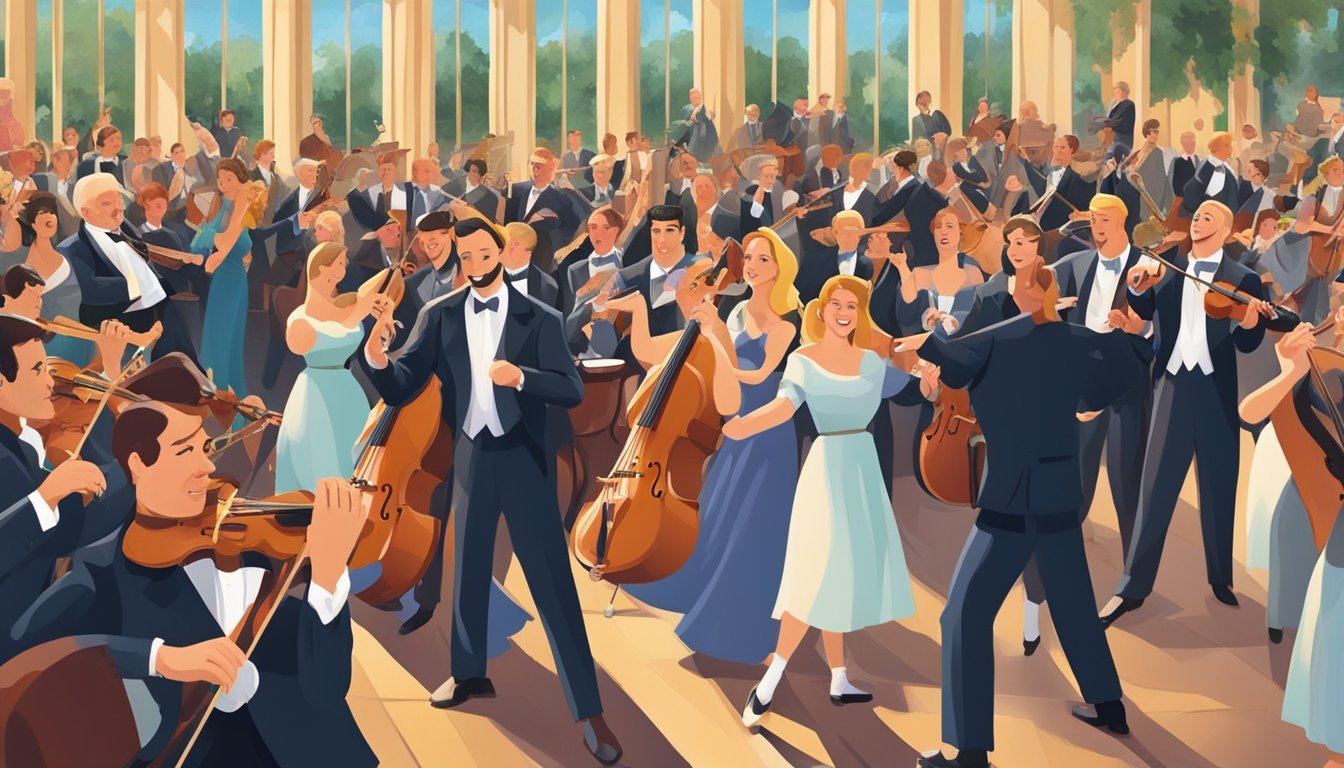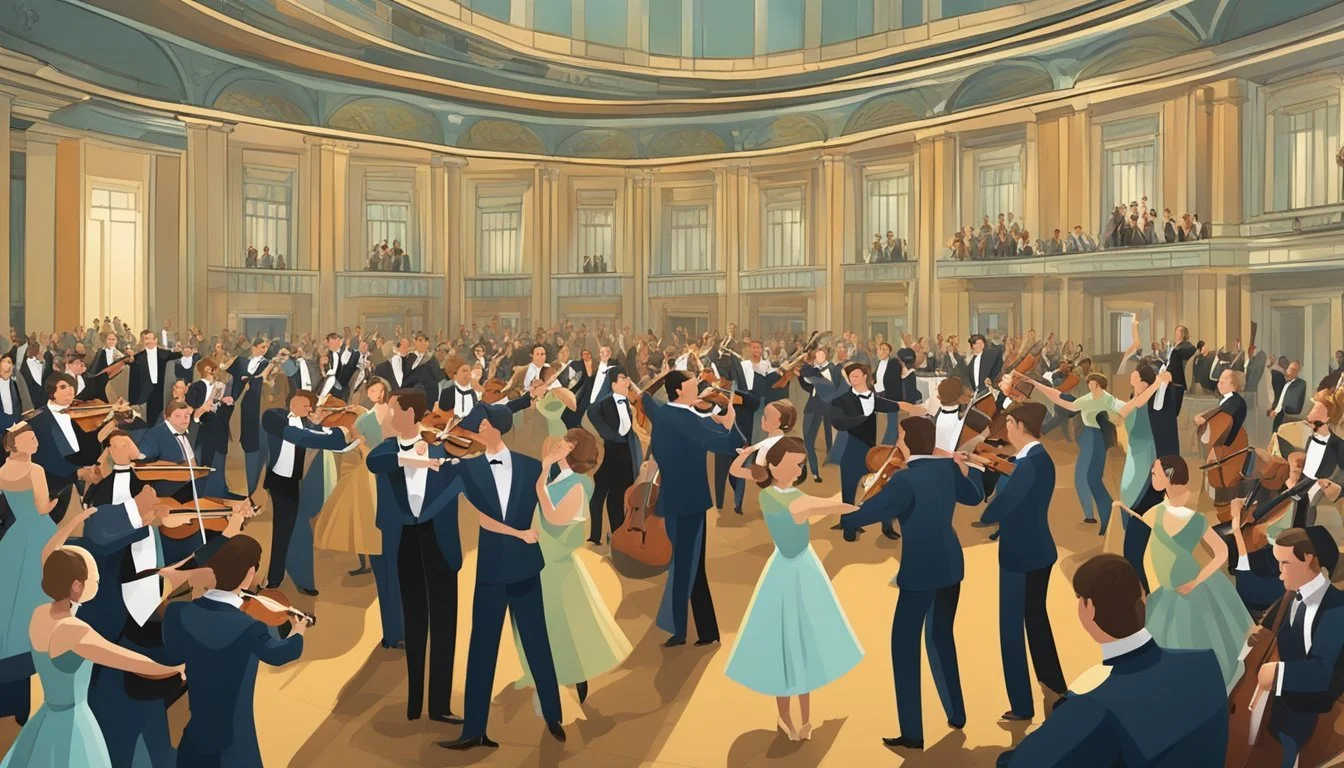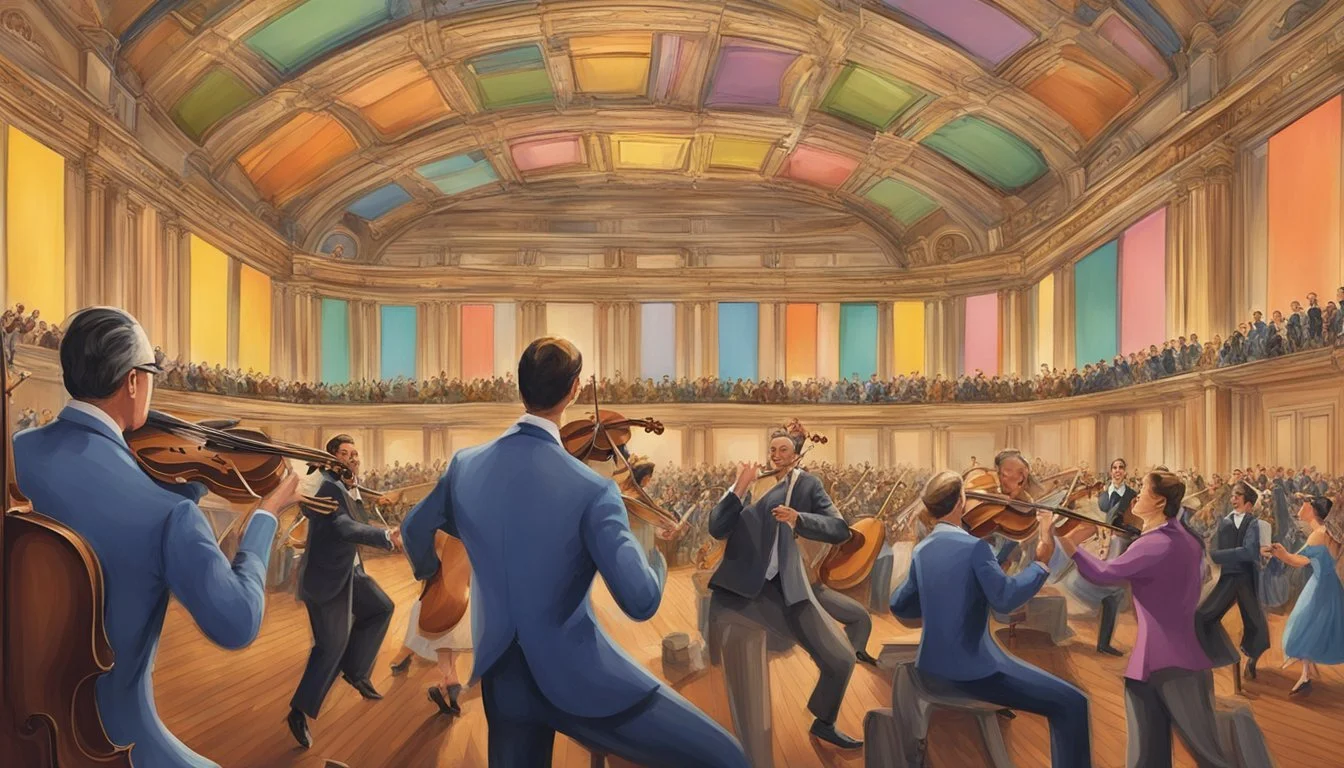German Music in Texas
Evolution from Polka Roots to Classical Grandeur
The intersection of German music and Texan culture represents a compelling facet of the Lone Star State's eclectic history. German immigrants brought with them a rich tapestry of musical traditions when they settled in Texas during the 19th century. These traditions have since permeated various aspects of Texan life, most notably in the Hill Country, where towns like Fredericksburg and New Braunfels stand as testament to this enduring influence. In these communities, the strains of classical music and the lively rhythms of polka can be heard, illustrating the seamless integration of German heritage into the broader cultural mosaic of Texas.
This musical fusion is most evident in the polka genre, which found fertile ground in Texas when German settlers mixed their cultural expressions with local styles. The polka, alongside the accordion, became a staple of social gatherings, influencing local genres such as norteño and conjunto music, which are now integral to the musical landscape of the region. In urban areas and at community festivals, the shared enjoyment of this infectious music has served to cultivate a sense of communal identity and intercultural understanding.
Beyond the dance halls and festive celebrations, the nuances of German music's influence extend to the Texan appreciation of classical music as well. Opera houses and concert halls in metropolitan areas of Texas are reminders of the German cultural allegiance to classical music, resonating with a dedication to preserve and honor the historical ties between two distinct, yet harmoniously intertwined, cultural narratives.
Historical Context of German Music in Texas
The tapestry of Texas music is rich with German threads, from the polka rhythms echoing in dance halls to the classical strings that resonate throughout its cultural heritage. This section explores the historical layers that German immigrants have woven into the musical fabric of Texas.
Early German Immigrants and Their Influence
The arrival of German immigrants in Texas can be traced back to the 1830s, bringing their cultural heritage with them. These settlers began to establish themselves in areas known today as New Braunfels and Fredericksburg, within the Texas Hill Country—a region sometimes referred to as the "German belt." These immigrants imported instruments such as the accordion, fiddle, and guitar, which would play central roles in the development of Texas's unique soundscapes.
The Development of Texas Polka Music
Polka music, characterized by its upbeat tempo and lively rhythms, found fertile ground in Texas at the hands of German, Czech, and Polish communities. The accordion became a signature instrument of Texas polka, providing the music with its distinctive sound that would reverberate through dance halls across the state. Polka bands, often featuring the fiddle as well, became mainstays at community gatherings and celebrations, solidifying polka's place in Texas's musical and cultural lore.
German Settlers' Cultural Impact on Texas
The influence of German settlers on Texan culture extends beyond music into the social sphere, with traditional dance halls emerging as communal hubs. These venues were more than mere entertainment locales; they served as vital cultural centers where German Texans preserved and perpetuated their heritage through music and dance. Today, the Texas State Historical Association recognizes the importance of these contributions, underscoring the indelible mark that German settlers left on the cultural heritage of the region.
Genres and Styles
The musical tapestry of Texas is rich with German influences that have helped shape the state’s distinctive genres and styles of music.
German Influences on Texas Folk Music
German settlers brought to Texas their rich musical heritage, which prominently features polka music and waltzes. These forms of music are typically characterized by a lively 2/4 time rhythm, known as pulka in Czech culture, which means "half-step." In Texas, these German polkas have become a staple within the local folk music scene, often featuring a strong presence of accordion orchestration.
Integration with Mexican and Czech Music
The intermingling of German music with Mexican and Czech traditions in Texas led to the creation of Tejano and Conjunto music. Norteño, a genre from northern Mexico with clear German influences, often mimics the "oom-pah-pah" of German polka bands. Instrumentation within these genres typically includes accordions and could feature a blend of brass and reed instruments, a cultural merge evident in many local performances.
Evolution of Texas Polka
As Texas music evolved, Texas Polka began to incorporate elements from other genres such as Western swing and ragtime, creating a unique sound that resonates across the state. Polka bands in central Texas often emphasize the use of German and Czech traditional instruments, while also adapting to include influences from local music styles. This melding of different cultural tones highlights the evolving nature of polka in Texas and its continuous adaptation over time.
Cultural and Social Aspects
German music in Texas has played a pivotal role in fostering community spirit and preserving cultural heritage. As a key aspect of social life, it contributes to the unity among diverse groups and adherence to traditions through festivals and dance halls, while organizations like vereins provide structures to support these activities.
German Music as a Unifying Community Force
German tunes, particularly polka, have become a staple in Texas communities, with family-friendly events fostering fellowship. Music acts as a unifier, embracing the values of freedom and equality ingrained within the Texan outlook. These gatherings often feature traditional costumes, enhancing the cultural immersion and giving a sense of belonging to attendees of all backgrounds.
Festivals and Dance Halls
Festivals:
These events showcase the vibrancy of German music, with the accordion and polka being central elements. Dance halls across Texas offer a physical space where the fusion of cultures is most apparent, engaging people in dance and festivities.
Notable Dance Halls:
Gruene Hall, New Braunfels
Schroeder Hall, Goliad
Vereins and Associations
Texas Polka Music Museum and Texas Polka News: Essential for education and scholarship in the realm of polka.
Vereins (associations) play a crucial role in maintaining the German culture through the organization of events and education. They are instrumental in sustaining the teachings of German music and dance, thereby preserving the traditions for future generations. Associations provide a foundation for cultural exchange and continued learning within the community.
Instruments and Performance
The cultural tapestry of Texas is vividly expressed through its music, especially within the German-influenced genres. This section explores the tools and talents that have shaped this rich musical landscape.
Instrumental Foundation and Variety
In Texas, German music is anchored by a diverse array of instruments such as the accordion, fiddle, piano, and guitar. The accordion, especially, stands out for its crucial role in polka and its presence in norteño music, reflecting a German influence on Mexican folk tunes. The melodious fiddle is used both to complement and enhance the explosive rhythm of polka bands. Pianos were imported by early German settlers, showcasing their affinity for classical music, while guitars have remained a staple across multiple genres.
Role of Bands and Ensembles
The heart of German music performance in Texas beats through its bands and ensembles. Polka bands, characterized by their lively sound and upbeat tempo, comprise a range of instruments including brass such as the horn, alongside the accordion and fiddle. These bands often perform in traditional costumes, which add visual allure to their auditory entertainment. The bands are an essential part of local festivals and gatherings, preserving the German heritage through their performances.
The Art of Dance and Performance
Dance is an indispensable element of the performance, acting as the physical embodiment of music. Polka bands create a vibrant environment prompting the audience into energetic dances such as the polka itself. The intricate dance steps and partnered movements are a spectacle closely tied to the music, with costumes often reflecting the style and era of the tunes played. Musical instruments thus serve not only as tools for melody and harmony but also as catalysts for the engaging art of dance in Texas' German music scene.
Influence on Modern Texas Music
The musical tapestry of Texas vividly illustrates the German influence, spanning genres from polka-inspired Tejano to classical music and opera cultivated by German Texans.
From Polka Roots to Diverse Genres
The advent of German settlers in the 1830s introduced polka and its distinctive "oom-pah-pah" rhythm to the local music scene, particularly influencing norteño music, a genre with roots in Northern Mexico and Texas. Tejano music, a later offshoot of norteño, further integrated polka's 2/4 time signature and eight-bar phrases. By the 1980s, this genre had solidified its position in Texas's cultural landscape. Texas music has not only retained these elements in traditional forms but also remixed them into other genres such as Western swing, which incorporates polka's rhythm into its upbeat dance tunes.
Genres Affected:
Tejano music: Direct polka influence with 2/4 rhythm.
Western swing: Upbeat dance tunes with polka rhythm.
Classical music: Refined by German Texan communities.
German Music's Legacy and Continuity
The German contribution persisted as Texas evolved, with classical music and opera becoming integral to Texas's cultural life, thanks to German immigrants who valued these art forms. Towns like Fredericksburg and New Braunfels remain beacons of this legacy, where music festivals often feature both traditional polka and classical performances. This musical infusion is a testament to the durability of German music’s influence, encompassing not only polka and related genres but also enriching the state’s classical music and opera scene.
Art Forms Enriched:
Classical music: Enhanced by German cultural appreciation.
Opera: Sustained and celebrated in Texas's German communities.
German Music Education and Preservation
German music education and preservation efforts in Texas involve various institutions dedicated to maintaining the state's rich cultural heritage. These entities champion the retention and dissemination of traditional German music through formal instruction, archival activities, and academic analysis.
Educational Institutions' Role
Texas has a variety of educational institutions that contribute to the learning and perpetuation of German music. Schools integrate German music into their curriculum, ranging from primary education to higher learning. This includes opportunities for students to study both theoretical and practical aspects of music. Music programs often explore German classical heritage and folk traditions, such as polka, which has a strong presence in Texas due to historical German immigration.
Museums and Historical Preservation
The Texas Polka Music Museum in Schulenburg serves as a steward of the state's polka history. It showcases a collection of artifacts, such as photographs, costumes, and musical instruments, that tell the story of German, Czech, and Polish influences on Texan music. Meanwhile, the Texas State Historical Association provides resources and information on the German musical impact in Texas, supporting historical understanding and appreciation.
Musical Scholarship and Ethnomusicology
Scholarly work in ethnomusicology offers a deep dive into the evolution and context of German music in Texas. Researchers analyze how German tunes have been integrated into Texan culture and how they have influenced other local music styles. Scholarships and grants support this research, facilitating a comprehensive study of music traditions and ensuring academic engagement with German-Texan musical heritage.
German Music's Impact on Texan Identity
German settlers contributed significantly to the musical landscape of Texas, intertwining their rich musical heritage with the diverse cultural tapestry of the state. This fusion not only enriched Texas' cultural identity but also cemented German music as a pivotal element of Texan heritage.
Ethnic Diversity and Musical Melting Pot
In the heart of Texas, the German influence is notable in the variety of music that rings across the state. From the National Polka Festival in Ennis to the intimate German musical soirées in Houston, German Texans have continuously fostered a rich cultural heritage. This legacy has led to a melting pot of ethnic sounds that reflects the diversity within Texan communities. The clear mark of German musical tradition on Texan identity is evidenced through various events and local customs that celebrate this fusion of cultures.
Major Festivals: Celebrations such as the Tejano Conjunto Festival, rooted in 1981, showcase a blend of German and Mexican styles.
Community Gatherings: Local soirees and festivals maintain communal bonds, emphasizing values like unity and cultural appreciation.
Symbolism and Reflection of Texan Values
German music acts as a symbol of the deeply-held Texan values of freedom and equality—principles that drew German immigrants to Texas land in the 1800s. Religious hymns and melodies from the German tradition often found their place within Texan churches, reflecting the importance of religion and community in daily life.
Architecture and Music: German Texan towns like Fredericksburg and New Braunfels marry German architectural styles with local customs, reflecting a blend of cultural heritage and regional identity.
Civil War Era: Post-Civil War, German music continued to be a medium for the expression of values, bridging old traditions with the evolving Texan ethos.
Texas' identity has been shaped by its German musical heritage, celebrating a spirit of community and freedom through a fusion of cultural legacies.
Commemoration and Future Directions
The legacy of German music in Texas, particularly polka, is not only preserved through museums and historical records, but it is also celebrated and advanced with contemporary interpretations and technology-driven experiences.
Anniversaries and Commemorative Events
Texas is home to numerous festivals that celebrate the state's German musical heritage, including the annual Wurstfest in New Braunfels, which honors German culture with music, food, and dance. These festivals often feature polka bands and serve as commemorative events, keeping the traditional sounds alive for new generations. Anniversaries of influential German-Texan musicians and bands are also marked with special concerts and tributes, ensuring that their contributions to the state’s cultural tapestry are not forgotten.
Innovation within Tradition
Innovation plays a crucial role in the continuation of German music traditions in Texas. Musicians and bands blend time-honored genres with new musical influences, which contributes to a living, evolving tradition that respects its roots while also embracing diversity. Contemporary artists often explore cross-genre collaborations, creating unique blends of polka with other music styles, thereby enriching the state's musical landscape.
Mobile Tours and Interactive Experiences
To engage a broader audience, especially younger generations, mobile tours and interactive experiences have been introduced. These utilize apps and other digital platforms to provide immersive tours of significant musical sites across Texas. Users can discover historical contexts, listen to music samples, and even learn dance steps, all from their mobile devices. Such innovations honor the enduring legacy of German music in Texas while adapting to contemporary modes of cultural engagement.






